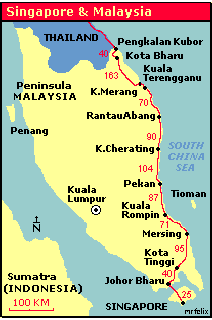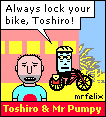 Ride 4
Singapore & Malaysia:
Ride 4
Singapore & Malaysia:
Up the East Coast to the Thai Border!
The
Ride: A
straight forward 700 km ride, from Singapore, up the east coast of Malaysia
to Kota Bharu and the Thai border. Safe, flat, good food and accommodation
and plenty of beach. It should take about a week to 10 days. 
The
Road: The road is beautifully paved the whole way and excellent
for riding. 
Once out of Singapore
(25 km of city) and through Johore Bahru (another 10 km) the
road passes through palm and rubber plantations, beside forested hills
and the further you go north, breaks into long ocean and palm tree vistas.
You can count the pot holes on one hand. 
The
ride in detail: Once
out of Singapore, you'll be heading for Kota Tinggi, and
the road passes through villages and rubber plantations for a lot of
the way. There's no serious hills but a few steady gradients, up and
down, all the way through to Mersing.
Mersing
is pretty much like the other regional centres up along the East Coast.
It's pleasant enough, but somewhat nondescript. Apart from eating, there
isn't a lot of night time action.
From
Mersing all the way up to Cherating the road is pretty
much dead flat and hugs the coast for most of the way. At times it twists
and turns through forested areas, and there are some very pleasant stretches
of road that will keep you amused.
Out
in the small towns the people are at their unhurried and friendly best
and will be curious when they see you ride in. Don't expect to be overwhelmed
with affection though - Malaysian hospitality is very understated.
Cherating
is the "Kuta Beach" (Bali) of Malaysia. There's a surviving
hippy feel here, and if you're into guitar playing and smoking the odd
reefer, then you might get lucky.
From
Cherating all the way up to Kampong Merang there is a swathe
of Guest Houses and you can ride along and pick the one you like.
Rantau
Abang has the famous Malaysian turtles, and it's maybe worth a look.
However, both times Mr Pumpy has been through there's been no turtles
to see, so he's a bit down on all things Rantau Abang.
"Did
you know, Felix, that Rantau Abang is an anagram of A RABAT AN GNU,
so they might have rabbits and gnus, but where's the turtles? Explain
that!" said a disgruntled Mr Pumpy.
"Well, I can't!" I said. And so we cycled off...
From
Merang through to Kota Bharu it's a 163 kilometre hop
along a flat road through a barren landscape, so there's not much joy
to be had. (I was told that there is actually a Guest House about 50
kilometres out of Kota Bharu, but exactly where I don't know.)
Kota
Bharu is a bustling town, with a great night market and a couple
of beaches a few kilometres down the road. The town is also the capital
of Kelantan State, which these days has a Muslim State Government and
Sharia (Islamic) Law in place.
Kelantan,
along with southern Thailand, is the centre of quite a bit of fundamentalist
Muslim activity. Although you may come across one or two folk wanting
to share their spiritual and political wisdom with you, most of the
time you'll be sweet. If things do get boring, do exactly what you do
at home: Don't take any shit, say "Good evening!", and walk
away.
Remember
also that the large Chinese and Indian populations aren't too happy
about Sharia Law either, so there's some safety in numbers on this litttle
problem..
From
Kota Bharu it's a 40 kilometre run up to the Thai border,
and if you go via Pengalan Kubor, it's a nice little run. The
road twists and turns through coconut groves and wooded valleys, and
the traffic is light.
The
Thai Border: There are two ways to cross into Thailand from
Kota Bharu.
The first, and
most common, is through Sungai Kolok, a rather boring run.
The second, and
rarely used, is through the Malaysian border town of Pengkalan Kubor
about 40 km north of Kota Bharu. This is an extremely pleasant
little run through a back corner of Malaysia that has wonderful Mosques
and small roadside cafes.
Over the border
and another 30 km up the coast will get you to Narathiwat, an
interesting little untouristed Thai town, which should serve as your
first overnight stop should you be continuing on into Thailand.
(See the Thailand:
North to ChiangMai! ride for more details.)
Best
time to go: The
monsoon pattern is complex and somewhat unpredictable on the East Coast.
June, July and August are probably the optimum months to go. There's
heavy rains from about September through December, and depending on
the year, the rains can come and go from January through to May.
Generally
when it rains, it'll be a short and sharp downpour, and you may only
have to sit it out for an hour or so.
However,
the most annoying bit is that the clouds will often gather throughout
the afternoon, and open up around 4 PM. This can really get in the way
of the riding, as you'll be attempting to make it to base before dark
at around 6:30 PM. It's a problem.
The
Towns: There's
actually not much to distinguish one town from the next. They're somewhat
uniform the whole way, either standard regional towns or small clusters
of beach style bungalows.
Rantau
Abang has turtles, apparently.
Accommodation:
A
room in a cheap hotel on Bencoolen St or Beach Rd in Singapore
will set you back about 10 dollars in a four bed dorm and 20 dollars
for a single/double room, depending on the quality. There's no 'beachy'
guest houses here, it's all city accommodation.
Once you cross
into Malaysia, the trick with this ride is to time your runs so that
you stay in the more 'beachy' style guest houses as much as possible,
rather than get stuck in a dive by the bus station in one of the main
towns. All of the coastal towns and kampongs (villages) on the map at
left have reasonably good accommodations of the former type. 
You
can get a good room in a Malaysian Guest House for as low as
5,10 or 15 dollars, depending on where it is. There are hotels and guest
houses at all major regional centres, and quite a few dotted along the
east coast at isolated spots.
Note: Over
the last few years, Malaysia's budget tourist industry seems to have
taken a dive, and some of the Guest Houses are now closed. Check
your Lonely Planet guide for details.
My
guess is that most of the tourists have moved to Thailand, which is
more tolerant of strange Western behaviour.
Traffic:
In Singapore the traffic is solid but reasonably well behaved
towards the crazy Western cyclist. A bike is perfect for Singapore,
as it's totally flat and everything is within easy striking distance.
Singapore is only about 40 km long at it's widest point.
In Malaysia
the traffic thins out immediately you leave Johore Bahru, and
is steady but constant the whole way north. It's a pretty well behaved
society, and the traffic is no exception. I had no scary traffic moments.

Hills:
None to speak of, but the road sweeps up and down between Jahore Bharu
and Mersing. Not too bad, just enough to keep you honest.
The
Bike:
A racer would be perfect for the job.
The roads are so
good in fact that you could happily keep going north all the way through
Thailand on a racer. However, there are a few unsealed B roads in Thailand,
so if you intend to do a bit of exploring off the A roads, a tourer
would be best overall. I rode my trusty mountain bike as usual, but
Malaysia is the one place I wished I was on a lighter framed/bigger
wheeled bike.
Ferries:
The only
one you will encounter is if you cross into Thailand, 40 km north of
Kota Bharu at the little town of Pengkalan Kubor.
Other
Cyclists:
Not many. I ran into a Canadian couple and one Japanese guy (see 'Toshiro's
ex-bike' at side).
Peter Thidholm
emails (DEC 02): If you thought it was lonely when you went, then
don't try it now: I didn't meet a single Westerner between Mersing and
Kota Bharu and I ran out of books about half way... (Thanks Peter and
oh, dear!)
Up along the coast
you will encounter a few locals on bikes. 
|

 x
x